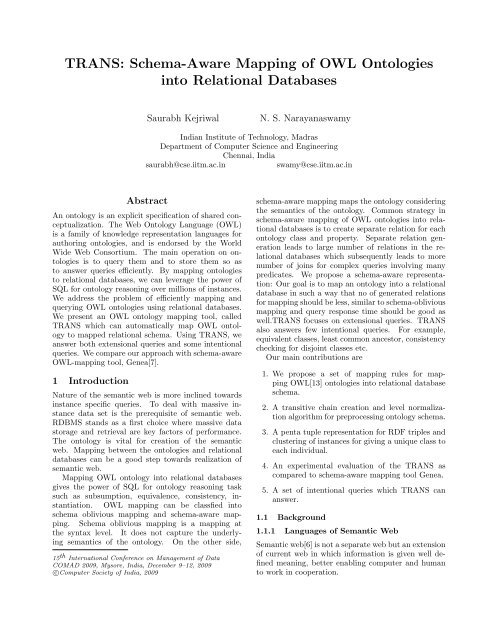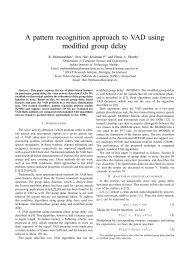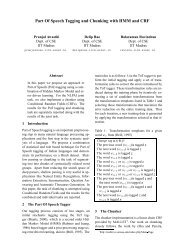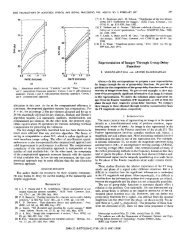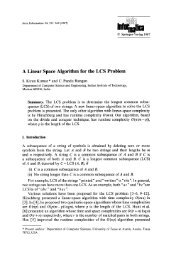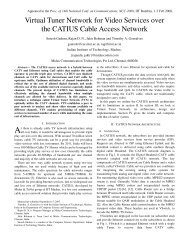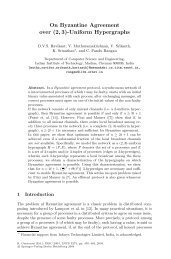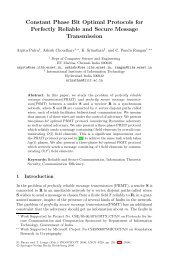TRANS: Schema-Aware Mapping of OWL Ontologies into Relational ...
TRANS: Schema-Aware Mapping of OWL Ontologies into Relational ...
TRANS: Schema-Aware Mapping of OWL Ontologies into Relational ...
Create successful ePaper yourself
Turn your PDF publications into a flip-book with our unique Google optimized e-Paper software.
<strong>TRANS</strong>: <strong>Schema</strong>-<strong>Aware</strong> <strong>Mapping</strong> <strong>of</strong> <strong>OWL</strong> <strong>Ontologies</strong><br />
<strong>into</strong> <strong>Relational</strong> Databases<br />
Saurabh Kejriwal<br />
N. S. Narayanaswamy<br />
Indian Institute <strong>of</strong> Technology, Madras<br />
Department <strong>of</strong> Computer Science and Engineering<br />
Chennai, India<br />
saurabh@cse.iitm.ac.in<br />
swamy@cse.iitm.ac.in<br />
Abstract<br />
An ontology is an explicit specification <strong>of</strong> shared conceptualization.<br />
The Web Ontology Language (<strong>OWL</strong>)<br />
is a family <strong>of</strong> knowledge representation languages for<br />
authoring ontologies, and is endorsed by the World<br />
Wide Web Consortium. The main operation on ontologies<br />
is to query them and to store them so as<br />
to answer queries efficiently. By mapping ontologies<br />
to relational databases, we can leverage the power <strong>of</strong><br />
SQL for ontology reasoning over millions <strong>of</strong> instances.<br />
We address the problem <strong>of</strong> efficiently mapping and<br />
querying <strong>OWL</strong> ontologies using relational databases.<br />
We present an <strong>OWL</strong> ontology mapping tool, called<br />
<strong>TRANS</strong> which can automatically map <strong>OWL</strong> ontology<br />
to mapped relational schema. Using <strong>TRANS</strong>, we<br />
answer both extensional queries and some intentional<br />
queries. We compare our approach with schema-aware<br />
<strong>OWL</strong>-mapping tool, Genea[7].<br />
1 Introduction<br />
Nature <strong>of</strong> the semantic web is more inclined towards<br />
instance specific queries. To deal with massive instance<br />
data set is the prerequisite <strong>of</strong> semantic web.<br />
RDBMS stands as a first choice where massive data<br />
storage and retrieval are key factors <strong>of</strong> performance.<br />
The ontology is vital for creation <strong>of</strong> the semantic<br />
web. <strong>Mapping</strong> between the ontologies and relational<br />
databases can be a good step towards realization <strong>of</strong><br />
semantic web.<br />
<strong>Mapping</strong> <strong>OWL</strong> ontology <strong>into</strong> relational databases<br />
gives the power <strong>of</strong> SQL for ontology reasoning task<br />
such as subsumption, equivalence, consistency, instantiation.<br />
<strong>OWL</strong> mapping can be classfied <strong>into</strong><br />
schema oblivious mapping and schema-aware mapping.<br />
<strong>Schema</strong> oblivious mapping is a mapping at<br />
the syntax level. It does not capture the underlying<br />
semantics <strong>of</strong> the ontology. On the other side,<br />
15 th International Conference on Management <strong>of</strong> Data<br />
COMAD 2009, Mysore, India, December 9–12, 2009<br />
c○Computer Society <strong>of</strong> India, 2009<br />
schema-aware mapping maps the ontology considering<br />
the semantics <strong>of</strong> the ontology. Common strategy in<br />
schema-aware mapping <strong>of</strong> <strong>OWL</strong> ontologies <strong>into</strong> relational<br />
databases is to create separate relation for each<br />
ontology class and property. Separate relation generation<br />
leads to large number <strong>of</strong> relations in the relational<br />
databases which subsequently leads to more<br />
number <strong>of</strong> joins for complex queries involving many<br />
predicates. We propose a schema-aware representation:<br />
Our goal is to map an ontology <strong>into</strong> a relational<br />
database in such a way that no <strong>of</strong> generated relations<br />
for mapping should be less, similar to schema-oblivious<br />
mapping and query response time should be good as<br />
well.<strong>TRANS</strong> focuses on extensional queries. <strong>TRANS</strong><br />
also answers few intentional queries. For example,<br />
equivalent classes, least common ancestor, consistency<br />
checking for disjoint classes etc.<br />
Our main contributions are<br />
1. We propose a set <strong>of</strong> mapping rules for mapping<br />
<strong>OWL</strong>[13] ontologies <strong>into</strong> relational database<br />
schema.<br />
2. A transitive chain creation and level normalization<br />
algorithm for preprocessing ontology schema.<br />
3. A penta tuple representation for RDF triples and<br />
clustering <strong>of</strong> instances for giving a unique class to<br />
each individual.<br />
4. An experimental evaluation <strong>of</strong> the <strong>TRANS</strong> as<br />
compared to schema-aware mapping tool Genea.<br />
5. A set <strong>of</strong> intentional queries which <strong>TRANS</strong> can<br />
answer.<br />
1.1 Background<br />
1.1.1 Languages <strong>of</strong> Semantic Web<br />
Semantic web[6] is not a separate web but an extension<br />
<strong>of</strong> current web in which information is given well defined<br />
meaning, better enabling computer and human<br />
to work in cooperation.
RDF Resource Description Framework (RDF)[15] is a<br />
family <strong>of</strong> World Wide Web Consortium (W3C) specifications<br />
originally designed as a metadata model, subsequently<br />
has come to be used as a general method<br />
<strong>of</strong> modeling information, through a variety <strong>of</strong> syntax<br />
formats.The underlying structure <strong>of</strong> any expression in<br />
RDF is a collection <strong>of</strong> triples. An RDF triple contains<br />
three components:<br />
• the subject, which is an RDF URI reference or a<br />
blank node<br />
• the predicate, which is an RDF URI reference<br />
• the object, which is an RDF URI reference, a literal<br />
or a blank node<br />
An RDF graph is set <strong>of</strong> such RDF triples.<br />
Example<br />
<br />
<br />
Anuj<br />
<br />
<br />
The above RDF construct describes “Anuj is the<br />
creator <strong>of</strong> the resource<br />
http://www.w3.org/Home/Anuj".<br />
RDFS RDF <strong>Schema</strong>[14], is a semantic extension <strong>of</strong><br />
RDF. It provides following additional features.<br />
• Classes and subclasses<br />
1. rdfs:Class: It allows to declare a resource as<br />
a class for other resources.<br />
2. rdfs:subClassOf: It allows to declare hierarchies<br />
<strong>of</strong> classes.<br />
• Property domain and range<br />
1. rdfs:domain: rdfs:domain <strong>of</strong> an rdf:property<br />
declares the class <strong>of</strong> the subject in a triple<br />
using this property as predicate.<br />
2. rdfs:range: rdfs:range <strong>of</strong> an rdf:property declares<br />
the class or datatype <strong>of</strong> the object in<br />
a triple using this property as predicate.<br />
<strong>OWL</strong> <strong>OWL</strong>[13] is a superset <strong>of</strong> RDF <strong>Schema</strong> and<br />
adds following more vocabulary. Additional <strong>OWL</strong> constructs<br />
are sameAs,differentFrom, disjointWith, complementOf,<br />
hasValue, equivalentProperty, equivalent-<br />
Class, inverseOf, FunctionalProperty, InverseFunctionalProperty,<br />
TransitiveProperty, SymmetricProperty,<br />
someValuesFrom, allValuesFrom, min/max Cardinality,<br />
oneOf, unionOf and intersectionOf. Following<br />
are the three flavors <strong>of</strong> <strong>OWL</strong>.<br />
<strong>OWL</strong> Lite <strong>OWL</strong> Lite uses only some <strong>of</strong> the <strong>OWL</strong> language<br />
features and has more limitations on the use <strong>of</strong><br />
the features than <strong>OWL</strong> DL or <strong>OWL</strong> Full. For example,<br />
in <strong>OWL</strong> Lite classes can only be defined in terms<br />
<strong>of</strong> named superclasses (superclasses can not be arbitrary<br />
expressions)<br />
<strong>OWL</strong> DL (Description logics[22]) <strong>OWL</strong> DL includes<br />
all <strong>OWL</strong> language constructs with certain restrictions.<br />
Example: a class may be a subclass <strong>of</strong><br />
many classes, a class can not be an instance <strong>of</strong> another<br />
class. <strong>OWL</strong> DL supports those users who want<br />
the maximum expressiveness while retaining computational<br />
completeness (all conclusions are guaranteed<br />
to be computable) and decidability (all computations<br />
will finish in finite time).<strong>OWL</strong> DL is so named due to<br />
its correspondence with description[22] background , a<br />
field <strong>of</strong> research that has studied the logics that form<br />
the formal foundation <strong>of</strong> <strong>OWL</strong>.<br />
<strong>OWL</strong> FULL <strong>OWL</strong> Full contains all the <strong>OWL</strong> language<br />
constructs and provides free, unconstrained use<br />
<strong>of</strong> RDF constructs.<br />
1.1.2 Ontology Reasoning Services<br />
Ontology reasoning service can be classified <strong>into</strong> following<br />
types.<br />
1. Consistency Checking: It checks for consistency<br />
<strong>of</strong> concepts. For example an instance can not be<br />
member <strong>of</strong> both VegPizza and NonvegPizza class<br />
if both VegPizza and NonvegPizza classes are disjoint.<br />
2. Subsumption Checking: Subsumption reasoning<br />
checks for the superclass and subclass reasoning<br />
questions. For example an instance which is member<br />
<strong>of</strong> Pr<strong>of</strong>essor class will be member <strong>of</strong> Human<br />
class also if Pr<strong>of</strong>essor is defined as subclass <strong>of</strong> Human<br />
class.<br />
3. Equivalence Checking: It answers the question<br />
whether concept A and concept B are equivalent.<br />
Equivalence can be <strong>of</strong> two types. One is both concept<br />
A and B are equivalent extensionally. This<br />
implies that they both have the same set <strong>of</strong> instances.<br />
Other one is both A and B are equivalent<br />
intentionally.<br />
4. Instantiation Checking: Instantiation asks the<br />
questions about instance membership. For example:<br />
Does an instance I belongs to a particular<br />
class C?<br />
5. Satisfiability Checking: Satisfiability reasoning<br />
checks whether any arbitrary concept expression<br />
can have an instance or not. In other words Is<br />
there any instance that satisfies that concept expression?
1.1.3 Types <strong>of</strong> Inference Strategy<br />
There are two types <strong>of</strong> inference strategies for ontology<br />
reasoners.<br />
1. Load time inference: In load time inference, we<br />
compute and store the closure <strong>of</strong> a given graph as<br />
a basis for querying. Genea[7] is an example <strong>of</strong><br />
Load time inference reasoner.<br />
2. Query time inference: Query time inference<br />
strategy allows the query processor infer new<br />
statements as needed per query. DLDB[9] and<br />
Seasame[2] use query time inference as their ontology<br />
reasoning strategy. <strong>TRANS</strong> is also a query<br />
time inference reasoner.<br />
1.2 Related Work<br />
Related work in ontology mapping can be classified<br />
<strong>into</strong> two types.<br />
<strong>Schema</strong>-oblivious mapping Seasame[2] is a schema<br />
oblivious approach for mapping RDF[15] AND RDF<br />
<strong>Schema</strong>[14]. Seasame design is independent <strong>of</strong> any<br />
specific storage devices. Underlying structure <strong>of</strong><br />
Seasame schema is <strong>of</strong> triple format[1, 11]. Seasame<br />
inserts inferred triples in the database table at the<br />
load time itself. This feature significantly increases<br />
the loading time for RDF and RDFS. Seasame<br />
schema is ontology independent means the structure<br />
<strong>of</strong> schema is fixed irrespective <strong>of</strong> ontology.<br />
<strong>Schema</strong>-aware mapping DLDB[9] is a knowledge<br />
based system, proposes a new schema-aware<br />
mapping approach for mapping <strong>OWL</strong> ontologies.<br />
It extends RDBMS with additional capability for<br />
DAML+OIL[18] inference. DLDB uses FACT description<br />
logic reasoner for computing <strong>OWL</strong> subsumption<br />
inference. It uses RDBMS views for storing class<br />
and property subsumption results. They have done<br />
light weight implementation <strong>of</strong> their approach using<br />
MS-Access and FACT[4] reasoner. DLDB presents<br />
the scaling performance <strong>of</strong> their system with increase<br />
in number <strong>of</strong> instances in the RDBMS and proves<br />
that idea <strong>of</strong> extending relational databases using<br />
description logic is feasible.<br />
The most closely related to our work is Genea[7].<br />
Genea[7] is a schema-aware mapping approach for<br />
mapping <strong>OWL</strong> ontologies <strong>into</strong> relational databases.<br />
It maps the basis <strong>of</strong> set <strong>of</strong> mapping rules. Genea<br />
maps each simple named classes to a separate relation<br />
and individuals to rows in (one or more) relations.<br />
Similarly for simple data and object property<br />
a separate relation is created in relational database.<br />
Main differences between Genea and <strong>TRANS</strong> are as<br />
follows: Genea uses materialization technique at load<br />
time for <strong>OWL</strong> subsumption inference, while <strong>TRANS</strong><br />
uses query time inference for <strong>OWL</strong> subsumption inference.<br />
Genea creates a separate relation for simple<br />
named class and property. On the other side, <strong>TRANS</strong><br />
creates a separate relation for each directed acyclic<br />
graph in ontology concept hierarchy.<br />
1.3 The Body <strong>of</strong> The Paper<br />
The remainder <strong>of</strong> paper is organized as follows. Section<br />
2 describes the architecture <strong>of</strong> <strong>TRANS</strong>. In section<br />
3, we describe <strong>TRANS</strong> mapped schema for LUBM<br />
University ontology fragment. Section 4 shows experimental<br />
setup. The results <strong>of</strong> an experimental evaluation<br />
<strong>of</strong> our mapping rules compared to Genea are<br />
presented in the section 5 and 6. Section 7 list <strong>of</strong> some<br />
intentional queries which <strong>TRANS</strong> can answer. The<br />
next section concludes.<br />
2 Architecture <strong>of</strong> <strong>TRANS</strong><br />
Figure 1 depicts the components involved for the complete<br />
mapping process. The architecture description<br />
is as follows:<br />
Definition 1. Let { D 1 , D 2 , D 1 ... D n } is a set<br />
<strong>of</strong> disjoint directed acyclic graph extracted out<br />
<strong>of</strong> concept hierarchy <strong>of</strong> an ontology O, D ir is a<br />
root node <strong>of</strong> the D i and D il is a leaf node <strong>of</strong> the<br />
D i then a transitive chain is a path <strong>of</strong> nodes<br />
< D ir , p 1 , p 2 ,... p n , D il > between D ir and D il<br />
including both D ir and D il . Here p 1 , p 2 ,... p n are<br />
intermediate nodes between D ir and D il .<br />
Definition 2. Let T i is a transitive chain and { N r ,<br />
N r+1 ,.... N l } is the set <strong>of</strong> nodes in the transitive<br />
chain Ti. Leveling is the process <strong>of</strong> numbering<br />
the nodes considering the constraint that for each<br />
node N i level Number <strong>of</strong> N i should be less than<br />
level number <strong>of</strong> N i+1 .<br />
Definition 3. Let { T 1 , T 2 , T 1 ... T n } is set <strong>of</strong><br />
transitive chains <strong>of</strong> disjoint directed acyclic graph<br />
D i (as mentioned in Definition 1) and D in is a node<br />
in the D i . If D in passes through the r transitive<br />
chains < T j , T j+1 , ... T j+r > with levels value<br />
< l j , l j+1 , ... l j+r > then normalization is the<br />
process <strong>of</strong> giving Max( l j , l j+1 , ... l j+r ) to node<br />
D in . Here Max represents maximum level value<br />
<strong>of</strong> all level numbers in < l j , l j+1 , ... l j+r >.<br />
2.1 <strong>TRANS</strong> Relation Generator<br />
<strong>TRANS</strong> uses the Jena[17] parser for parsing the<br />
input ontology file. The <strong>TRANS</strong> relation generator<br />
generates the relations out <strong>of</strong> ontology concept data.<br />
Relations are created in relational databases for<br />
the ontology through <strong>TRANS</strong> rules for mapping.<br />
Following are the <strong>TRANS</strong> schema-aware mapping<br />
rules.
Figure 1: Architecture <strong>of</strong> <strong>TRANS</strong> schema aware mapping tool<br />
2.1.1 <strong>Schema</strong>-<strong>Aware</strong> <strong>Mapping</strong> Rules<br />
Overview <strong>of</strong> schema-aware mappping rules<br />
In <strong>TRANS</strong>, schema-aware mapping rules are executed<br />
by <strong>TRANS</strong> relation generator component in the<br />
<strong>TRANS</strong> architecture. These rules are not ontology independent.<br />
It means number <strong>of</strong> relations generated<br />
changes from ontology to ontology. Here in Rules<br />
RM stands for relational model. <strong>TRANS</strong> supports<br />
reasoning at RDFS level(subsumption, instantiation,<br />
property domain and range based reasoning). These<br />
four kinds <strong>of</strong> reasoning are supported by schema-aware<br />
mapping rules 1, 2, 3 and 5. Apart from this, <strong>TRANS</strong><br />
also supports some <strong>of</strong> the <strong>OWL</strong> intentional queries.<br />
Example: class disjointness reasoning. Rule 5 is used<br />
for this purpose.<br />
Rule 1:Simple named classes, subsumption<br />
RM: Class[CId INT, IndivURI VARCHAR(130)]<br />
PRIMARY KEY [IndivURI]<br />
UNIQUE [CId, IndivURI]<br />
RM: store_level[TransCId INT, CId INT,<br />
CURI VARCHAR(130), Level INT,<br />
DisjointId INT]<br />
PRIMARY KEY [TransCID, CId, CURI, Level]<br />
<strong>TRANS</strong> mapps each disjoint directed acyclic graph<br />
for ontology class hierarchy <strong>into</strong> a relation Class.<br />
In the Class relation IndivURI is the primary key.<br />
Ontology class subsumption information is mapped<br />
to store_level relation. Here store_level relation<br />
stores all the transitive chains <strong>of</strong> the ontology class<br />
hierarchy.<br />
Rule 2: Simple object properties and subsumption<br />
RM: ObjectProperty [ Domain INT,<br />
Indiv1URI VARCHAR(130), PropId INT,<br />
Indiv2URI VARCHAR(100), Range INT ]<br />
PRIMARY KEY [Indiv1URI, Indiv2URI]<br />
UNIQUE [Domain, Indiv1URI, PropId,<br />
Indiv2URI, Range]<br />
RM: store_plevel[ TransPId INT, PId INT,<br />
PURI VARCHAR(130), Level INT]<br />
PRIMARY KEY [TransPId, PId, PURI, Level]<br />
Similar to ontology class hierarchy, <strong>TRANS</strong> maps<br />
each disjoint directed acyclic graph for ontology object<br />
property hierarchy <strong>into</strong> a relation ObjectProperty.<br />
In the ObjectProperty relation Indiv1URI and Indiv2URI<br />
together make primary key. Ontology object<br />
property subsumption information is mapped to<br />
store_plevel relation. Here store_plevel relation<br />
stores all the transitive chains <strong>of</strong> the ontology object<br />
property hierarchy.<br />
Rule 3: Simple datatype properties and<br />
subsumption<br />
RM: DataProperty [Domain INT,<br />
IndivURI VARCHAR(130), PropId INT,<br />
Value VARCHAR(160)]<br />
PRIMARY KEY [IndivURI, Value]<br />
UNIQUE [Domain, IndivURI, PropId,<br />
Value]<br />
RM: store_dplevel[TransDPId INT, PId INT,<br />
PURI VARCHAR(130), Level INT]<br />
PRIMARY KEY [TransDPId, PId, PURI, Level]
Similar to ontology object property hierarchy, <strong>TRANS</strong><br />
maps each disjoint directed acyclic graph for ontology<br />
data property hierarchy <strong>into</strong> a relation DataProperty.<br />
In the DataProperty relation IndivURI and<br />
Value together make primary key. Ontology data<br />
property subsumption information is mapped to<br />
store_dplevel relation. Here store_dplevel relation<br />
stores all the transitive chains <strong>of</strong> the ontology<br />
data property hierarchy.<br />
Rule 4: Class disjointness<br />
RM: store_level[TransCId INT, CId INT,<br />
CURI VARCHAR(130), Level INT,<br />
DisjointId INT]<br />
UNIQUE [Transcid, Disjointid]<br />
Here we check the Disjointness <strong>of</strong> two classes by<br />
DisjointId attributes. If two classes are disjoint then<br />
they can not lie in the same transitive chain. Transcid<br />
and Disjointid together make primary key.<br />
Rule 5: Property domain and range<br />
RM: PropDomain[PId INT, DomainClasses INT]<br />
PRIMARY KEY [PId, DomainClasses]<br />
RM: PropRange[PId INT,<br />
PRIMARY KEY [PId, RangeClasses]<br />
RangeClasses INT]<br />
Property Domain and Range information is mapped<br />
to PropDomain and PropRange relation respectively.<br />
In PropDomain relation, PId and DomainClasses<br />
together make primary key. In PropRange relation,<br />
PId and RangeClasses together make primary key.<br />
Rule 6: Relations for storing clustering<br />
data information<br />
RM: Cluser_Class[ClusterCId INT, CId INT]<br />
PRIMARY KEY [ClusterCId INT, CId INT]<br />
RM: Cluster_Property[ClusterPId INT, PId INT]<br />
PRIMARY KEY [ClusterPId INT, PId INT]<br />
These relations stores newly created clustered<br />
classes and properties out <strong>of</strong> <strong>TRANS</strong> cluster operation.<br />
In Cluster_Class relation, ClusterCId and CId<br />
together make primary key. In Cluster_Property relation<br />
ClusterPId and PId together make primary key.<br />
2.2 Preprocessor<br />
The preprocessor preprocesses the ontology concept<br />
hierarchy using the Pellet[10, 12] reasoner. A set <strong>of</strong><br />
transitive chains is extracted out <strong>of</strong> ontology concept<br />
hierarchy by algorithm 1. The algorithm 1 also assigns<br />
a level number to each node in the transitive<br />
chain. Here level number <strong>of</strong> a node in a transitive<br />
chain is equal to its distance from the root node + 1.<br />
All the extracted transitive chains are populated <strong>into</strong><br />
the transitive chain relations created by rule 1, 2 and<br />
3. Algorithm 1 describes the transitive chain creation<br />
for ontology class hierarchy. Same transitive chain creation<br />
is done for the ontology property hierarchy also.<br />
input : O, An <strong>OWL</strong> ontology file<br />
output: A set <strong>of</strong> <strong>OWL</strong> class transitive chains<br />
and corresponding levels<br />
begin<br />
for Each root class R ɛ<br />
RootHierarchyClasses (O) do<br />
Transid ←− 1 ;<br />
Transid = Transid + 1 ;<br />
Print (Transid);<br />
Push (R);<br />
PrintTransChain(R);<br />
end<br />
PrintTransChain (R)<br />
begin<br />
Leaf ←− 0 ;<br />
for Each each S ɛ subClassOf (R) do<br />
Leaf ←− 1 ;<br />
Push (S);<br />
PrintTransChain (S);<br />
if Leaf = 0 then<br />
PrintStackElements ();<br />
if StackNotEmpty () then<br />
Pop ();<br />
end<br />
PrintStackElements ()<br />
begin<br />
Level ←− 1 ;<br />
while IterateAllStackElements () = False<br />
do<br />
PrintStackElement ();<br />
Print (Level);<br />
Level ←− Level + 1 ;<br />
end<br />
Algorithm 1: <strong>OWL</strong> Class Trans chain creation<br />
algorithm<br />
2.3 Transitive Chain Level Normalizer<br />
The transitive chain level normalizer normalizes the<br />
level numbers <strong>of</strong> nodes in the transitive chains created<br />
by algorithm 1. Normalization is the process <strong>of</strong> giving<br />
unique level number to each node. Algorithm 2<br />
describes the transitive chain level normalization pro-
cess for ontology class hierarchy.<br />
input : A set <strong>of</strong> <strong>OWL</strong> class transitive chains<br />
output: Normalized set <strong>of</strong> transitive chain where<br />
[ClassId(C1) = ClassId(C2)] =⇒<br />
[level(C1) = level(C2)]<br />
begin<br />
for Each Class id C ɛ<br />
OccursMoreThenOneTransChain ( C) = True<br />
do<br />
UpdateRightClass ( C);<br />
end<br />
UpdateRightClass (C)<br />
begin<br />
LMax ← MaxLevel ( C);<br />
for Each Transitive id T <strong>of</strong> C do<br />
Level ← LevelT ( T) ;<br />
Diff ← LMax- Level ;<br />
for Each Class Id Where GetLevel ( C)<br />
≥ Level do<br />
Check ←<br />
OccursMoreThenOneTransChain ( C) ;<br />
if Check = True then<br />
UpdateRightClass (C);<br />
else<br />
for Each Class Id Where<br />
GetLevel ( C) ≥ Level do<br />
Level ← GetLevel (C) + Diff ;<br />
end<br />
Algorithm 2: <strong>OWL</strong> Class Trans Chain Normalization<br />
algorithm<br />
side part <strong>of</strong> the figure 2 shows the ontology class hierarchy<br />
after the normalization process.<br />
2.4 Ontology Instance Data Populator<br />
The ontology instance data populator populates the<br />
ontology instance data <strong>into</strong> corresponding relations.<br />
It populates the class instance and property instance<br />
data.<br />
2.5 Ontology Instance Data Cluster<br />
Ontology instance data cluster clusters the ontology<br />
instance data in such a way that each instance should<br />
have a unique class. Similar is done for the triples also.<br />
For example if I1 and I2 are two instances connected<br />
with property P1 and P2 then these two triples will<br />
be clustered <strong>into</strong> a single triple and a new property id<br />
is generated. This way ontology instance data cluster<br />
generates new classes and properties due to clustering<br />
for both ontology classes and properties. Population <strong>of</strong><br />
these newly generated classes and properties <strong>into</strong> the<br />
transitive chain relations is dealt by next component.<br />
2.6 Transitive Chain Modifier<br />
Transitive chain modifier is the last component in the<br />
<strong>TRANS</strong> architecture. Transitive chain modifier populates<br />
newly generated classes and properties due to<br />
clustering <strong>into</strong> the transitive chain relations.<br />
3 Ontology <strong>Mapping</strong> Example<br />
Following is the fragment <strong>of</strong> LUBM University ontology.<br />
LUBM is the Lehigh University benchmark ontology<br />
for university domain. We add one object property<br />
pr<strong>of</strong>TrainingFrom in this fragment.<br />
3.1 LUBM University Ontology Fragment<br />
<br />
assistant pr<strong>of</strong>essor<br />
<br />
<br />
Figure 2: Reflection <strong>of</strong> Transitive chain creation and<br />
normalization algorithm<br />
Figure 2 reflects the transitive chain creation and<br />
normalization <strong>of</strong> a given class hierarchy. Here in figure<br />
2 node labels denote class labels like C1 denotes<br />
class 1 and number on top <strong>of</strong> label denotes level number<br />
<strong>of</strong> the node like class c3 got two level numbers<br />
2 and 3. In figure 2, left side part <strong>of</strong> the figure depicts<br />
the situation <strong>of</strong> ontology class hierarchy before<br />
the normalization operation. In normalization, class<br />
labels are numbered considering the constraint that<br />
each node should get a unique level number. Right<br />
<br />
associate pr<strong>of</strong>essor<br />
<br />
<br />
<br />
faculty member<br />
<br />
<br />
<br />
lecturer<br />
<br />
Figure 3: <strong>TRANS</strong> transitive chains for LUBM University ontology fragment<br />
<br />
post doctorate<br />
<br />
<br />
Employee is the superclass <strong>of</strong> the class Faculty.<br />
3.3 <strong>TRANS</strong> Mapped <strong>Schema</strong><br />
<br />
pr<strong>of</strong>essor<br />
<br />
<br />
<br />
visiting pr<strong>of</strong>essor<br />
<br />
<br />
<br />
Work<br />
<br />
<br />
has an Pr<strong>of</strong>essional Training from<br />
<br />
<br />
<br />
<br />
<br />
<strong>of</strong>fice room No.<br />
<br />
3.2 Transitive Chain Creation for LUBM University<br />
Ontology Fragment<br />
Figure 3 depicts the transitive chain creation for example<br />
LUBM University ontology fragment. Here<br />
{Employee, Faculty, PostDoc} is one transitive<br />
chain with node levels 1, 2 and 3 respectively. Here<br />
Figure 4: <strong>TRANS</strong> mapped schema for LUBM University<br />
ontology fragment<br />
Following is the description <strong>of</strong> relations in the figure<br />
4. These relations are generated as per <strong>TRANS</strong><br />
schema-aware mapping rules.<br />
1. DDClass_Table1: It stands for Disjoint Directed<br />
acyclic class graph table1. It stores all the asserted<br />
individuals <strong>of</strong> AssistantPr<strong>of</strong>essor, AssociatePr<strong>of</strong>essor,<br />
Faculty, Lecturer, Postdoc, Pr<strong>of</strong>essor<br />
and VisitingPr<strong>of</strong>essor class.<br />
2. DDClass_Table2: It stands for Disjoint Directed<br />
acyclic class graph table2. It stores all the asserted<br />
individuals <strong>of</strong> work class.
3. DDOProp_Table1: It stands for Disjoint Directed<br />
acyclic object property graph table1. It stores<br />
property instances <strong>of</strong> object property Pr<strong>of</strong>TrainingFrom.<br />
4. DDDProp_Table1: It stands for Disjoint Directed<br />
acyclic datatype property graph table1. It stores<br />
property instances <strong>of</strong> datatype property <strong>of</strong>ficeNumber.<br />
5. PropDomain: It stands for domain <strong>of</strong> properties.<br />
It stores domain information <strong>of</strong> Pr<strong>of</strong>TraningFrom<br />
property.<br />
6. PropRange: It stands for range <strong>of</strong> properties.<br />
It stores range information <strong>of</strong> Pr<strong>of</strong>TrainingFrom<br />
property.<br />
7. store_level: It stores the transitive chains and<br />
levels <strong>of</strong> the university ontology class hierarchy.<br />
8. store_plevel: It stores the transitive chains and<br />
levels <strong>of</strong> the university ontology object property<br />
hierarchy.<br />
9. store_dplevel: It stores the transitive chains<br />
and levels <strong>of</strong> the university ontology data property<br />
hierarchy.<br />
4 Experimental Setup<br />
Following is experimental setup.<br />
Processor: 2.6 GHz Intel Celeron Processor<br />
RAM: 1 GByte RAM<br />
Hard disk: 80 GByte<br />
Operating System: Fedora Core 3<br />
Database: PostgreSQL 8.1<br />
JDBC Driver: JDBC driver 3<br />
Java: Sun JDK 1.5.0<br />
<strong>TRANS</strong> is compared with Genea schema aware<br />
mapping tool as Genea performs better than the<br />
other available schema aware mapping tools in the<br />
literature. Both <strong>TRANS</strong> and Genea tool are experimented<br />
on the above experimental setup. We use<br />
the data generator tool UBA version 1.7[16] with<br />
seed value 0 to generate LUBM University ontology<br />
random individual data. For comparing <strong>TRANS</strong> with<br />
Genea we have built eleven LUBM test sets (LUBM 1,<br />
LUBM 3, LUBM 5, LUBM 7, LUBM 10, LUBM 15,<br />
LUBM 20, LUBM 25, LUBM 30, LUBM 40, LUBM<br />
50) that correspond to size <strong>of</strong> 10 to 500 MBytes.<br />
Genea Genea was implemented in MySQL[19]<br />
database and <strong>TRANS</strong> is implemented in<br />
PostgreSQL[20]. So to have a fair comparison,<br />
we obtained Genea source code from Genea author<br />
and customized some part <strong>of</strong> it to make it work<br />
with PostgreSQL. We use the SQL script <strong>of</strong> Genea<br />
Query no. Input Selectivity Description from LUBM Benchmark and Genea paper<br />
1 large high Queries about just one class and one property and<br />
does not assume any hierarchy information or inference.<br />
3 large high Similar to Query 1 but class Publication has a wide<br />
hierarchy.<br />
4 small high It assumes subClassOf relationship between Pr<strong>of</strong>essor<br />
and its subclasses. Class Pr<strong>of</strong>essor has a wide<br />
hierarchy. Another feature is that it queries about<br />
multiple properties <strong>of</strong> a single class.<br />
6 large low This query queries about only one class. But it assumes<br />
both the explicit subClassOf relationship between<br />
UndergraduateStudent and Student and implicit<br />
one between GraduateStudent and Student.<br />
7 large high This query is similar to Query 6 in terms <strong>of</strong> class<br />
Student but it increases in the number <strong>of</strong> classes and<br />
properties.<br />
11 small low to high depending on the used dataset Inference about the subOrgnizationOf relationship<br />
between instances <strong>of</strong> ResearchGroup and University<br />
is required to answer this query.<br />
14 large low This query is the simplest in the test set, as it relies<br />
only on one triple.<br />
Table 1: Selected LUBM queries for <strong>TRANS</strong> and Genea<br />
specified in their source code for ontology schema<br />
creation. Genea is also experimented on the above<br />
experimental setup.<br />
<strong>TRANS</strong> <strong>TRANS</strong> uses Pellet[10, 12] reasoner for computing<br />
ontology hierarchy and Jena[17] reasoner for<br />
ontology data loading as Jena is not able to return<br />
some <strong>of</strong> the asserted conceptual data. Query response<br />
time is calculated based on Genea specified<br />
SQL queries for LUBM test queries.In <strong>TRANS</strong>, for<br />
having a more fair comparison query response time is<br />
calculated without the cache effect. For flushing the<br />
cache effect, we restarted our system before every new<br />
LUBM[3] test query reading for both <strong>TRANS</strong> and Genea.<br />
Table 1 lists the set <strong>of</strong> selected LUBM test queries<br />
for both <strong>TRANS</strong> and Genea. In table 1, Query no.<br />
column specifies the selected LUBM query number,<br />
Input column specifies the size <strong>of</strong> ontology input data<br />
for a query, Selectivity column depicts the estimated<br />
proportion <strong>of</strong> the class instances involved in the query<br />
that satisfy the query criteria and Description column<br />
specifies about the nature <strong>of</strong> each queries. Following<br />
are the reasons for query selection. We got Genea SQL<br />
queries and code from Genea author. Genea experimented<br />
on the set <strong>of</strong> queries in table 1 so to have<br />
a fair comparison <strong>TRANS</strong> also tested on the same<br />
set <strong>of</strong> LUBM test queries. Another reason is <strong>TRANS</strong><br />
currently does not directly support SPARQL[23] and<br />
RQL[8] ontology languages. LUBM test queries in<br />
SPARQL are mapped to corresponding SQL queries.<br />
Queries in table 1 operates directly on database and<br />
easy to be converted <strong>into</strong> SQL for fair comparison.<br />
5 Query and <strong>Schema</strong> Complexity<br />
Comparison<br />
Query complexity comparison is done on the basis <strong>of</strong><br />
number <strong>of</strong> select, join and union clauses used in the
Query Joins Unions Selects<br />
1 1 0 1<br />
3 0 0 1<br />
4 3 0 1<br />
6 1 0 1<br />
7 2 0 1<br />
11 1 0 1<br />
14 1 0 1<br />
Table 2: Query complexity <strong>of</strong> <strong>TRANS</strong> mapped queries<br />
for selected LUBM test queries<br />
Query Joins Unions Selects<br />
1 2 0 1<br />
3 2 0 1<br />
4 5 0 1<br />
6 1 0 1<br />
7 4 0 1<br />
11 3 0 1<br />
14 1 0 1<br />
Table 3: Query complexity <strong>of</strong> Genea mapped queries<br />
for selected LUBM test queries<br />
SQL query. Select, Join and Union are important factors<br />
for calculation <strong>of</strong> SQL query complexity. Query<br />
complexity table 2 for <strong>TRANS</strong> and 3 for Genea shows<br />
that <strong>TRANS</strong> needs less number <strong>of</strong> joins in compare to<br />
Genea.<br />
5.1 Comparison <strong>of</strong> Query Complexity <strong>of</strong><br />
<strong>TRANS</strong> and Genea<br />
As specified in the experimental setup, query complexity<br />
comparison is done on the queries listed in table<br />
1. Table 1 specifies input size and selectivity factors<br />
for query complexity which are also important factors<br />
similar to select, join and union factors for query complexities.<br />
Table 2 Query column specifies the LUBM test<br />
queries. Apart from that joins, unions and selects<br />
columns are used to measure SQL query complexity <strong>of</strong><br />
<strong>TRANS</strong> mapped SQL queries for LUBM test queries.<br />
These test queries are the same queries on which Genea<br />
author evaluated Genea. Similar to <strong>TRANS</strong> query<br />
complexity table, table 3 specifies the query complexity<br />
table for Genea. Both <strong>TRANS</strong> and Genea are<br />
evaluated on the same set <strong>of</strong> LUBM test queries. For<br />
Union and select clause both Genea and <strong>TRANS</strong> have<br />
the same query complexity but for joins Genea has<br />
more query complexity. <strong>TRANS</strong> has less query complexity<br />
for query 1, 3, 4, 7 and 11. For query 6 and<br />
14 both <strong>TRANS</strong> and Genea have the same query complexity.<br />
Query complexity table 2 for <strong>TRANS</strong> and 3<br />
for Genea shows that <strong>TRANS</strong> needs less number <strong>of</strong><br />
joins in compare to Genea.<br />
Complexity parameters <strong>TRANS</strong> Genea<br />
No <strong>of</strong> tables 39 76<br />
No <strong>of</strong> foreign keys 0 109<br />
No <strong>of</strong> views 0 0<br />
No <strong>of</strong> indexes 217 141<br />
Table 4: <strong>Schema</strong> complexity for LUBM ontology<br />
5.2 Comparision <strong>of</strong> <strong>Schema</strong> Complexity <strong>of</strong><br />
<strong>TRANS</strong> and Genea<br />
Table 4 specifies the schema complexity for <strong>TRANS</strong><br />
and Genea schema-aware mapping tool for LUBM ontology.<br />
As per table 4, <strong>TRANS</strong> needs less number <strong>of</strong><br />
tables in compare to Genea. Need <strong>of</strong> less number <strong>of</strong> tables<br />
makes <strong>TRANS</strong> more scalable in compare to Genea<br />
for larger ontologies. Genea stores ontology semantic<br />
constraints in terms <strong>of</strong> foreign keys so it needs foreign<br />
keys listed in table 4.<br />
6 Query Performance Comparison<br />
In the query response curves, x-axis specifies the<br />
LUBM benchmark factor(LUBM(N,S)). For example<br />
benchmark factor 5 specifies LUBM(5,0) as we uses<br />
seed value 0, specified in experimental setup. Y-axis<br />
specifies the query response time in milliseconds. We<br />
have applied least square linear curve fitting[21] over<br />
the query performance curves. A least square linear<br />
fit minimizes the square <strong>of</strong> the distance between every<br />
data point and the line <strong>of</strong> the best fit.<br />
6.1 Query1<br />
Query 1 requests for all Graduate students who takes<br />
a given course. It does not assume any hierarchy information<br />
or inference. The result <strong>of</strong> comparison is<br />
shown in Figure 5.<br />
Figure 5: Query response time <strong>of</strong> LUBM Query 1 with<br />
curve fitting
6.2 Query3<br />
Query 3 requests for all the publications <strong>of</strong> a given pr<strong>of</strong>essor<br />
where the class publication has wide hierarchy.<br />
It bears large input and high selectivity. The result <strong>of</strong><br />
comparison is shown in Figure 6.<br />
6.4 Query6<br />
Query 6 selects all individuals who are student assuming<br />
both implicit and explicit subclass<strong>of</strong> relationship.<br />
It bears large input and low selectivity and produce a<br />
big set <strong>of</strong> results. The result <strong>of</strong> comparison is shown<br />
in Figure 8.<br />
Figure 6: Query response time <strong>of</strong> LUBM Query 3 with<br />
curve fitting<br />
Figure 8: Query response time <strong>of</strong> LUBM Query 6 with<br />
curve fitting<br />
6.3 Query4<br />
Query 4 demands name, emailaddress, telephone <strong>of</strong><br />
all the pr<strong>of</strong>essors who work for a given department in<br />
University where class pr<strong>of</strong>essor has wide hierarchy.<br />
It increases query complexity by requesting multiple<br />
properties <strong>of</strong> a pr<strong>of</strong>essor class and has small input and<br />
high selectivity. Figure 7 depicts the result <strong>of</strong> comparison.<br />
6.5 Query7<br />
Query 7 selects students and courses taken by them,<br />
considering that course is <strong>of</strong>fered by a given pr<strong>of</strong>essor.<br />
It is similar to Query 6 in terms <strong>of</strong> student but with<br />
more properties and classes and its selectivity is high.<br />
The result <strong>of</strong> comparison is shown in Figure 9.<br />
Figure 9: Query response time <strong>of</strong> LUBM Query 7 with<br />
curve fitting<br />
Figure 7: Query response time <strong>of</strong> LUBM Query 4 with<br />
curve fitting<br />
6.6 Query11<br />
Query 11 requests for all research group who are suborganization<br />
<strong>of</strong> given one. The result <strong>of</strong> comparison is<br />
shown in Figure 10.
‘exampleclass’) and transcid IN (select<br />
transcid from store_level where curi =<br />
‘exampleclass’)<br />
Similarly for superclasses query also, it enumerate<br />
the set <strong>of</strong> all ancestors <strong>of</strong> a class.<br />
Example Give all the superclasses <strong>of</strong> a class named<br />
exampleclass.<br />
select CURI from store_level where Level
8 Conclusions and Future Work<br />
<strong>TRANS</strong> is a new schema aware approach for mapping<br />
<strong>OWL</strong> ontologies in relational databases. It has succeeded<br />
in performing better in both query response<br />
time and space used to store the ontology instance data<br />
compared to Genea. Unlike the other schema aware<br />
approach <strong>TRANS</strong> does not map each class or property<br />
to a separate table which would not lead to exponential<br />
increase in number <strong>of</strong> tables for an ontology <strong>of</strong><br />
too many classes. Although <strong>TRANS</strong> does some preprocessing<br />
over ontology hierarchy for computing transitive<br />
chain but preprocessing should be one time as<br />
structure <strong>of</strong> ontology usually does not change. <strong>TRANS</strong><br />
currently supports <strong>OWL</strong> subsumption reasoning, instantiation,<br />
some consistency checking and also some<br />
intentional queries which is not supported by Genea.<br />
One direction for future work on <strong>TRANS</strong> would<br />
be to extends its reasoning capability to support full<br />
consistency checking. Another direction is to provide<br />
direct support for SPARQL[23] queries. Currently<br />
<strong>TRANS</strong> provides indirect support for SPARQL<br />
queries.<br />
References<br />
[1] S. Alexaki, V. Christophides, G. Karvounarakis,<br />
and D. Plexousakis. On storing voluminous RDF<br />
descriptions. In Proceedings <strong>of</strong> the 4th International<br />
Workshop on the Web and Databases<br />
(WebDB), pages 43–48, 2001.<br />
[2] J. Broekstra, A. Kampman, and F. van Harmelen.<br />
Seasame: A generic architecture for storing and<br />
querying RDF and RDF schema. International<br />
Semantic Web Conference (ISWC), 2342:54–68,<br />
2002.<br />
[3] Y. Guo, Z. Pan, and J. Heflin. LUBM: A benchmark<br />
for <strong>OWL</strong> knowledge base systems. Journal<br />
<strong>of</strong> Web Semantics, pages 158–182, 2005.<br />
[4] Ian Horrocks. The FACT system. International<br />
Conference on Automated Reasoning with Analytic<br />
Tableaux and Related Methods, pages 307–<br />
312, 1998.<br />
[5] Ian Horrocks. Ontology reasoning:Why and How.<br />
URL:www.comlab.ox.ac.uk/people/ian.horrocks/<br />
../DL-ontology-langs.ppt.<br />
[6] Ian Horrocks Introduction to Semantic Web.<br />
www.cs.man.ac.uk/ horrocks/Teaching/cs646/.<br />
[7] T. Kraska and U. Rohm. Genea: <strong>Schema</strong>-aware<br />
mapping <strong>of</strong> ontologies <strong>into</strong> relational databases.<br />
International Conference on Management <strong>of</strong> Data<br />
(COMAD), pages 103–114, 2006.<br />
[8] G. Karvounarakis, S. Alexaki, V. Christophides,<br />
D. Plexousakis and M. Scholl RQL: A Declarative<br />
Query Language for RDF. Eleventh International<br />
World Wide Web Conference (WWW),<br />
pages 592–603, 2002.<br />
[9] Z. Pan and J. Heflin. DLDB: Extending relational<br />
databases to support semantic web queries.<br />
Workshop on Practical and scalable Semantic<br />
Systems (PSSS1), pages 109–113, 2003.<br />
[10] B. Parsia and E. Sirin. Pellet: An <strong>OWL</strong> DL<br />
reasoner. Poster in International Semantic Web<br />
Conference (ISWC), 2004.<br />
[11] A. Reggiori. RDFStore: Perl/C rdf storage and<br />
api. URL:http://rdfstore.sourceforge.net, 2004.<br />
[12] The Pellet Team. Pellet - an <strong>OWL</strong> DL reasoner.<br />
URL:http://clarkparsia.com/pellet<br />
[13] W3C. The web ontology language (<strong>OWL</strong>).<br />
URL:http://www.w3.org/2004/<strong>OWL</strong>/.<br />
[14] W3C. RDF vocabulary description language<br />
1.0: Resource description framework <strong>Schema</strong>.<br />
URL:http://www.w3.org/TR/2004/REC-rdfconcepts-20040210/.<br />
[15] W3C. RDF concepts and abstract syntax.<br />
URL:http://www.w3.org/TR/2004/REC-rdfconcepts-20040210/.<br />
[16] The Semantic Web and Agent Technologies<br />
Lab(SWAT). LUBM benchmark. URL:<br />
http://swat.cse.lehigh.edu/projects/lubm/.<br />
[17] The Jena Team.Jena - a semantic web framework<br />
for java. URL:http://www.jena.sourceforge.net/.<br />
[18] W3C. DAML+OIL(2001) reference description.<br />
URL:http://www.w3.org/TR/daml+oil+reference.<br />
[19] The MySQL Team. MySQL - an open source<br />
database. URL:http://dev.mysql.com/doc/.<br />
[20] The PostgreSQL Team. PostgreSQL database.<br />
URL:http://www.postgresql.org/docs/.<br />
[21] The Wolfrom Team. Least square linear curve fitting.<br />
URL:http://mathworld.wolfram.com /Least-<br />
SquaresFitting.html.<br />
[22] Description Logics. The Course Slides <strong>of</strong> DL.<br />
URL:http://www.inf.unibz.it/franconi/dl/course.<br />
[23] W3C. The SPARQL Query Language for RDF.<br />
URL:www.w3.org/TR/rdf-sparql-query/.


